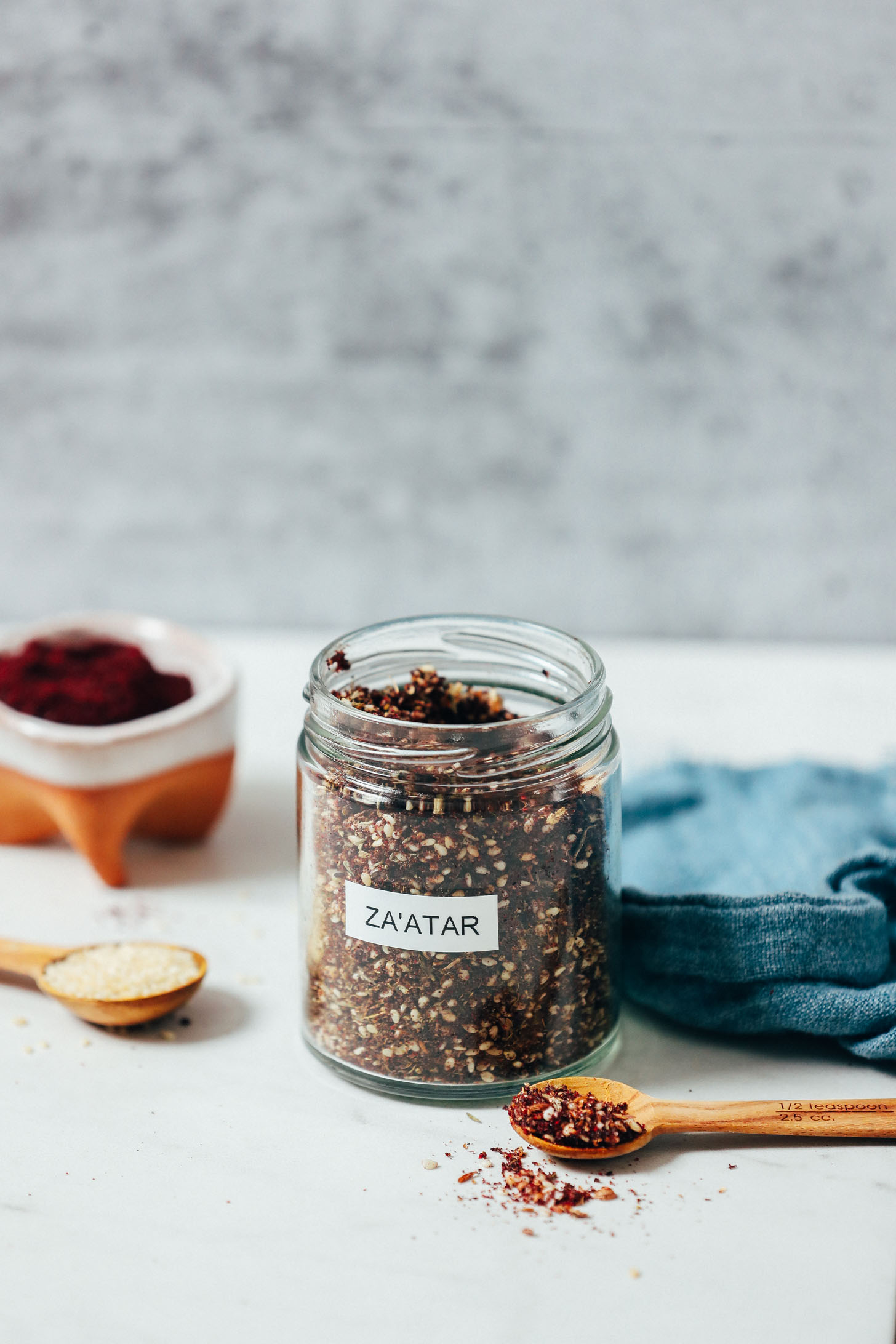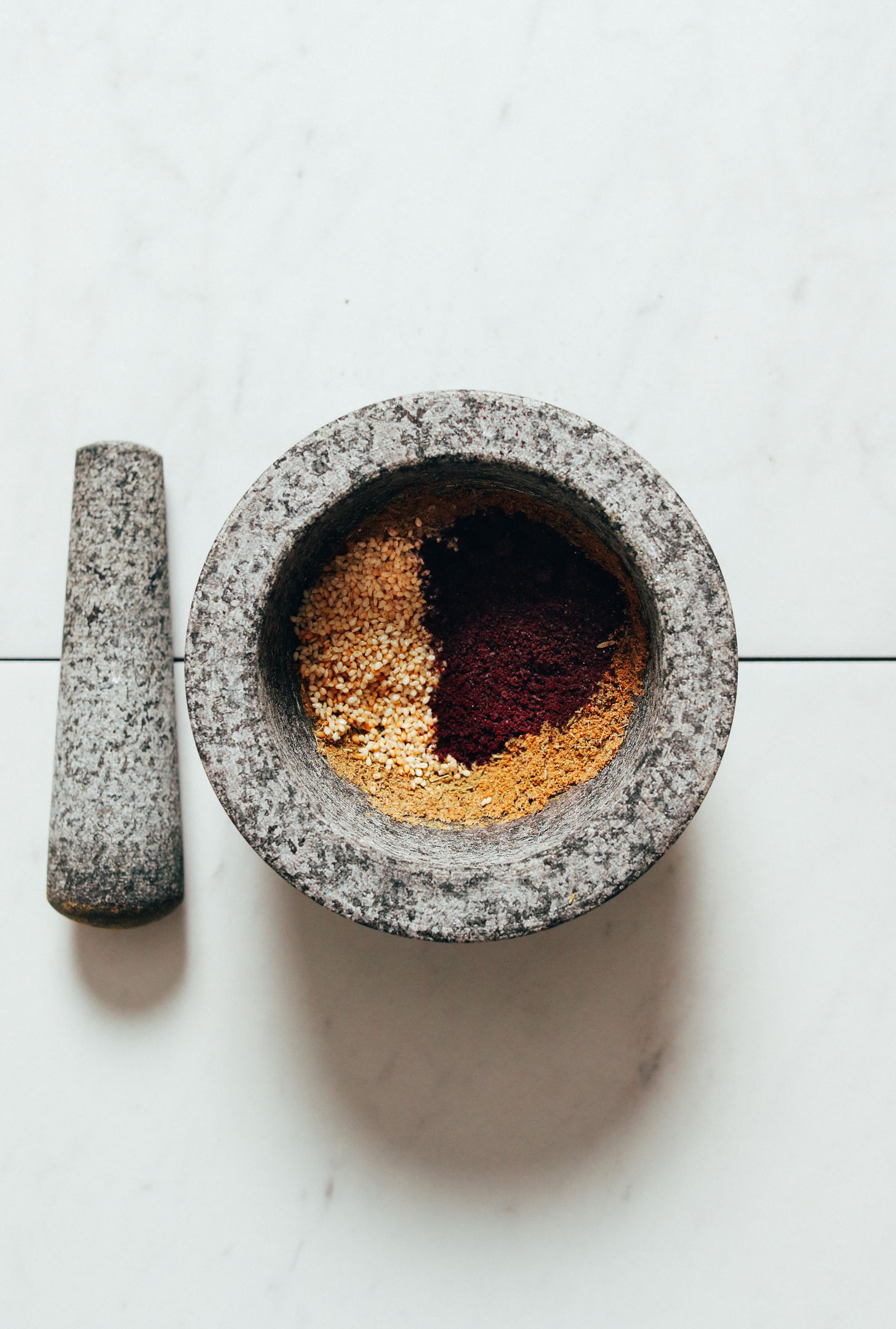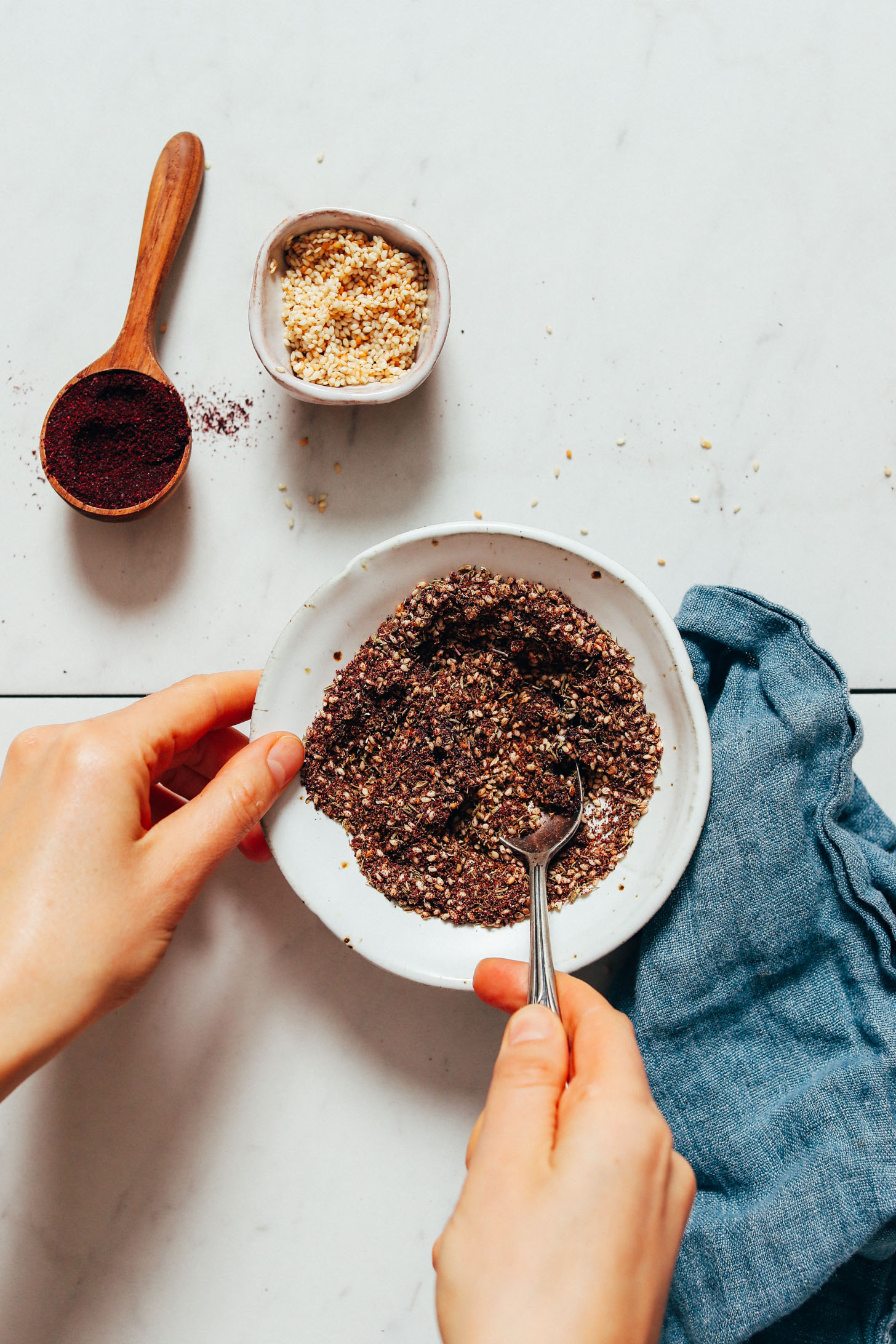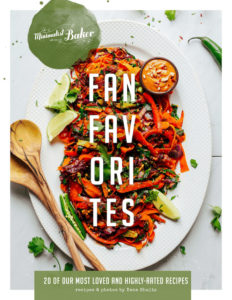
Introducing my inspired take on za’atar — a classic Middle Eastern spice blend with toasted sesame seeds, sumac, and herbs.
After tasting both red and green za’atar, I tried my hand at a classic red version featuring sumac.
This inspired version is gluten-free and requires only 6 ingredients and 5 minutes to prepare!

What is Za’atar?
The term za’atar has been used to describe both an herb (wild oregano or hyssop) and a mix of herbs and spices that can include this herb. But in this post, we’re referring to the spice mix.
Za’atar is common in several countries in the Middle East and Mediterranean regions. And it’s especially popular in Lebanon, Palestine, Israel, and Syria. The exact herbs and spices used vary, but typically include a mix of sesame seeds, salt, and dried herbs. Our inspired version most closely resembles the Lebanese version because of the addition of sumac. (source)
What is Sumac?
Sumac is a vibrant spice made from the dried, ground berry of the wild sumac flower, and is especially rich in vitamin C and antioxidants. I love the unexpectedly bright, tart flavor of sumac, and how it blends beautifully with the sesame and herbs in this spice blend.
If you aren’t sure where to purchase sumac, we recommend the bulk section of a well-stocked health food store or ordering online.
How to Make Za’atar
It starts with toasting sesame seeds in a small skillet.
The toasted sesame seeds are then lightly crushed in a mortar and pestle (a small blender or mixing bowl will also work). Then the other spices are added: thyme, oregano, cumin, sea salt, and sumac.

A final optional step is to add olive oil. This is ideal if you are going to be using your za’atar immediately to flavor a dish.
If not using within a week or so, we recommend omitting the olive oil and keeping the spice mix in a sealed container stored at room temperature or in the refrigerator for longer-term storage. As a practice, we find it’s always best to check the aroma and taste of herbs and spice blends before using them in recipes. If you haven’t used a spice in 6+ months, it’s probably time to retire it.

We hope you LOVE this spice mix! It’s:
Herbal
Smoky
Tangy
Salty
Savory
& Very versatile
It’s perfect for marinating or seasoning meats, garnishing dips and salads, raw vegetables, or adding more flavor to just about any dish, especially those that are Middle Eastern or Mediterranean inspired, including hummus, grilled chicken, or roasted vegetables.
If you try this recipe, let us know! Leave a comment, rate it, and don’t forget to tag a photo #minimalistbaker on Instagram. Cheers, friends!
More DIY Spice Mixes

Za’atar
Ingredients
- 2 Tbsp sesame seeds, toasted
- 1 Tbsp dried thyme
- 1 Tbsp dried oregano
- 1 Tbsp ground cumin
- 1/4-1/2 tsp sea salt
- 1 ½-2 Tbsp sumac
- 1-2 Tbsp olive oil (optional)
Instructions
- If using untoasted sesame seeds, heat a small skillet over low to medium heat. Add sesame seeds and toast for a few minutes or until lightly golden brown, stirring frequently.
- Transfer toasted sesame seeds to a mortar, small blender, or small mixing bowl, along with thyme, oregano, cumin, sea salt (starting with lesser amount), and sumac. Use either the pestle, blender, or a spoon to combine the mixture. Add olive oil (optional) near the end and mix again to combine.
- Taste test and adjust as needed, adding more cumin for smokiness, salt to taste, sumac for tartness, thyme for floral notes, oregano for a woodsy taste, or sesame seeds for sesame flavor and more texture. NOTE: The amount of salt you add will depend on preference. If you typically add more salt to dishes, hold back a bit. If you want this to be a stand-alone spice blend that seasons a salad or hummus, etc., a greater amount of salt is nice for balance and flavor.
- Perfect for marinating or seasoning meats, garnishing dips and salads, or adding more flavor to just about any dish, especially those that are Middle Eastern or Mediterranean inspired, including hummus, grilled chicken, or roasted vegetables.
- Will keep in a sealed container for at least 3 months (or longer) at room temperature. Or, refrigerate to keep fresh even longer.
Video
Notes
*Nutrition information is a rough estimate calculated without optional olive oil.







Diana says
I don’t like sauerkraut and wonder if you would suggest a substitute here? I do love roasted beets–might that lead anywhere? Thanks : )
Hi Diana, we’re not sure on your question here. Did you mean to comment on a different recipe?
LaTrice Mays says
Hello,
I saw where you can order the sumac brand you posted on amazon but reviews are saying they received anise instead. Please help me with this I’m excited to start making this herb and want to order the right kind of Sumac. ty ty soooo much. I live in Louisiana and can’t find it no where here in Monroe :( . Can’t wait to start making it!
Hi LaTrice, Any ground sumac should work well here. Here’s an example of another brand. Hope that helps!
LaTrice Mays says
Thanks so much Minimalist Baker,
This stuff is very VERY POPULAR LOL! I’m on a waiting list by email for it to restock. I will check Whole Foods also. Can’t wait to make it!
Lily Baker says
I took a pic of our gorgeous pan-seared chicken thighs we made last night crusted in your Za’atar! Scrumptious! But you have to take my word because I can’t figure out how to post a pic and I don’t do social media.
Lily Baker says
I didn’t get to finish my thoughts! We didn’t have much luck pulverizing the sesame seeds, so they were lightly crushed and it was wonderful. Also, because I’ve recently become addicted to it, I added about a T of Aleppo pepper. This was so savory and smoky and complex, we all had leftovers for breakfast today!!! Thank you for your excellent and well-tested recipes! In our experience they’ve each one been winners!
Sounds lovely! Thanks for sharing, Lily!
Bella says
where is the glass jar from?!
It’s a leftover Culina yogurt jar!
Dustin says
Amazing! thank you so much!
We’re so glad you enjoyed it! xo
Susan says
I highly suggest using the plant za’atar instead of oregano in this recipe, especially since the author has chosen to call it a recipe for za’atar, without a trace of the actual herb. I live in the part of the world when it is commonly grown and easy to find, but after a simple search on the Internet, it seems that you can find it in North America as well.
Kate says
Susan:
I’ve seen what my Lebanese husband calls za’atar (plant) on the west coast of the US. I guess it’s also called Syrian oregano according to Google anyway. I’ve never seen it growing wild or available at stores/plant shops on the east coast.
Dima says
Hi Susan, I’m pretty sure that za’tar is Thyme (I’m Lebanese) and it is indeed used in the recipe. I haven’t ever had the Za’tar mix with oregano but I’m going to try it, it sounds like it could be an interesting twist on the traditional mix ;)
Jessica says
I made this last night and used it to make za’atar bread today – it was delicious and so easy! Sumac is such a wonderful spice that I don’t encorpoarete enough. I will definitely be making this regularly!
Whoop! Thanks for sharing, Jessica!
Reena Desai says
Zatar is a different herb, often confused with thyme and oregano.
Christy says
I will definitely be making this! I wish I had this last summer as I needed it for a few recipes I wanted to try out. I couldn’t find Za’tar anywhere! I did find sumac, and I’ve since found Za’tar, but would rather make my own. Question, what’s the advantage or reason to add olive oil? I know you say it’s optional and good if you’re using right away, but why? I’m just curious since I’ve only seen this spice mix dry. Thanks!
Adding olive oil will moisten the mixture a bit and add more nuance and flavor. However, if planning to store it longterm (longer than 1-2 weeks), I wouldn’t add the olive oil as oils usually go rancid before spices. Hope that helps!
Christy says
Yes, makes sense. Thank you!
We appreciate the feedback, Shan! We’ve gotten other similar comments and will make sure to modify our language here! We are admittedly not experts on this topic and thought our research was correct / sufficient. Will make improvements asap!
LFFH says
We use this herb A LOT (im Arab haha) and it honestly has so many uses (on bread, in salads, on fish/chicken- even can make zaatar flavoured savoury granola lol)… if you wanna take your zaatar up a notch I would highly recommend adding some lemon salt! That acidity you get from the sumac is more prominent with it
Ooh, great tip! Never would have thought of lemon salt!